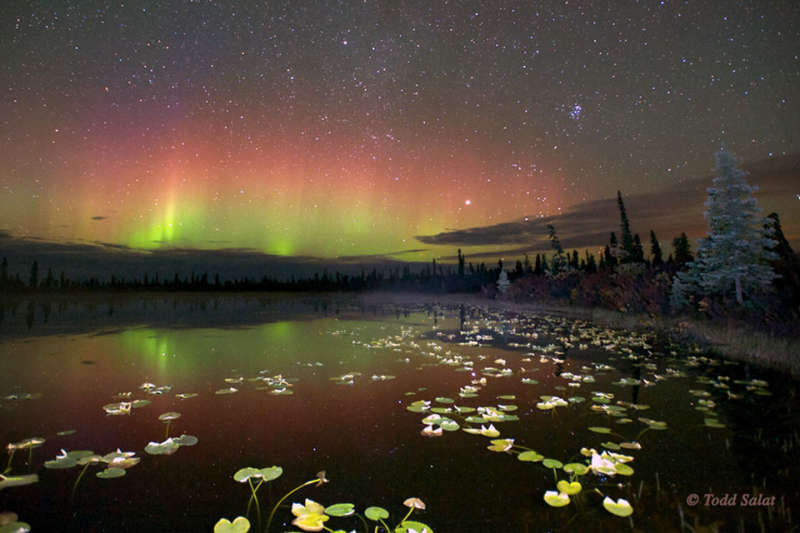Credit & Copyright: Todd Salat (AuroraHunter);
Sky Annotation:
Judy Schmidt
Explanation:
Some auroras
can only be seen with a camera.
They are called
subvisual
and are too faint to be seen with the unaided eye.
In the
above image,
the green aurora were easily visible to the eye,
but the red aurora only became apparent after a 20-second camera exposure.
The reason is that the human eye
only accumulates light for a fraction of a second at a time,
while a camera shutter can be left open much longer.
When photographing an already picturesque scene near
Anchorage,
Alaska,
USA, last autumn,
a camera caught both the visual green and subvisual red aurora
reflected in a lily pad-covered lake.
High above, thousands of stars were visible including the
Pleiades star cluster,
while the planet Jupiter posed near the horizon, just above clouds, toward the image
right.
Auroras
are caused by
energetic particles from the
Sun impacting the Earth's
magnetosphere,
causing electrons
and
protons
to rain down near the Earth's poles and impact the air.
Both red and green aurora are
typically created by excited
oxygen atoms,
with red emission, when visible, dominating higher up.
Auroras
are known to have many
shapes and
colors.
1999 2000 2001 2002 2003 2004 2005 2006 2007 2008 2009 2010 2011 2012 2013 2014 2015 2016 2017 2018 2019 2020 2021 2022 2023 2024 2025 |
Yanvar' Fevral' Mart Aprel' Mai Iyun' Iyul' Avgust Sentyabr' Oktyabr' Noyabr' Dekabr' |
NASA Web Site Statements, Warnings, and Disclaimers
NASA Official: Jay Norris. Specific rights apply.
A service of: LHEA at NASA / GSFC
& Michigan Tech. U.
|
Publikacii s klyuchevymi slovami:
aurora borealis - severnoe siyanie
Publikacii so slovami: aurora borealis - severnoe siyanie | |
Sm. takzhe:
Vse publikacii na tu zhe temu >> | |
